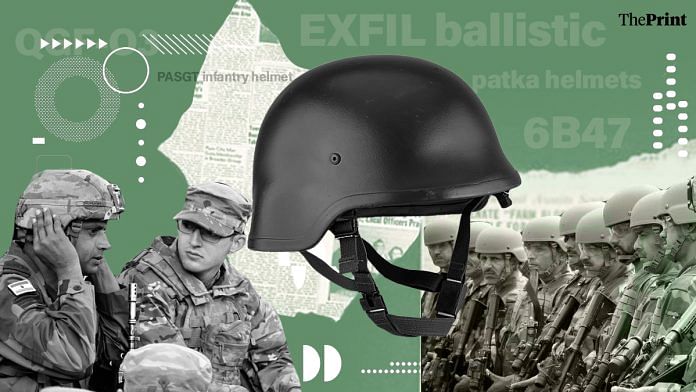New Delhi: The India-US ‘Yudh Abhyas’ in Rajasthan last month has sparked comparisons between the helmets worn by Indian and American troops. While the US soldiers wore ballistic helmets during the joint military exercise, Indians troops were equipped with mere bullet-proof helmets, which provide little protection.

This is not the first time that such comparisons have emerged. In 2018, when India-US conducted the ‘Yudh Abhyas’ in Uttarakhand’s Chaubatia, the US Army’s official X handle posted a photo of an Indian Army personnel trying on the Advanced Combat Helmet of one of the US troops. Many social media users, at the time, noticed the drastic differences in the helmets of the two sides.
A lot has changed since 2018. The standard-issue Model 1974 Helmet was around till 2018. Kanpur-based Indian company MKU’s bullet-proof helmets have replaced them now. The phasing out of older models for newer ones though is an ongoing process.
Model 1974, with its fibre-glass body and nylon suspender, could withstand a round from a 9mm carbine, but an AK-47 round from close range could easily pierce it. In 2018, the Indian Army ordered 1,58,000 bullet-proof helmets from MKU, but these do not help against AK-47 bullets.
When it came to counter-insurgency operations in Jammu and Kashmir and the Northeast, Indian soldiers made a jugaad—patkas. Rounded, thick steel with a combat cloth around it, a patka protects soldiers from close-range heavy firing, say from an AK-47 used by militants. However, patkas are crude and heavy, weighing roughly 2.5 kg. Also, patkas do not provide full protection, covering only the forehead and back of the head. There have been cases where soldiers using patkas were injured due to hits to the head or ricochets.
Back in 2018, the Indian Army, apart from the MKU helmets, ordered nearly 1.6 lakh Kevlar-based helmets, which are lighter. But, to this day, soldiers in several operational areas continue to rely on the patkas during close encounters with insurgents.
In 2020, the Army started procuring ballistic helmets by issuing an RFI (request for information). Currently, 4.8 lakh frontline troops have ballistic helmets. According to Army sources, 40 percent of the procurement is complete, while 50 percent is left. Roughly 10 percent of the procurement will be left untouched for future development, i.e., in case of any technological advancements, the Army will get new versions of those helmets, ensuring that at least some frontline troops get the newer versions.
Several Army commands and specific units have already gone in for specialised ballistic helmets that provide better protection and allow the soldier to use several gadgets. For instance, troops in the Special Forces use the EXFIL ballistic helmets, which feature a hybrid composite shell for increased strength and a unique geometry for optimal fit. India acquired the US-made EXFIL High Cut Ballistic Helmet in limited numbers in 2020.
Moreover, MKU has designed its first combat helmet for Sikh soldiers. The Kavro SCH-112-T—a special ballistic helmet that Sikh soldiers can wear on the top of their turban—provides ‘all-round ballistic protection’.
MKU has exported over 30,000 helmets to the Philippines Army and police forces, according to a report. Several other countries, such as Indonesia, Thailand, Malaysia and Egypt, have shown an interest in MKU body armour, including helmets.
MKU, in November last year, unveiled its latest product, the Kavro Doma 360 lightweight ballistic helmet, at MiliPol in Paris.